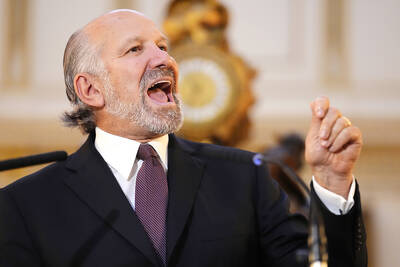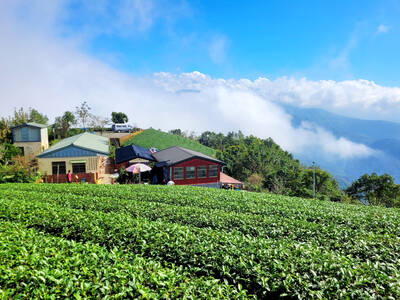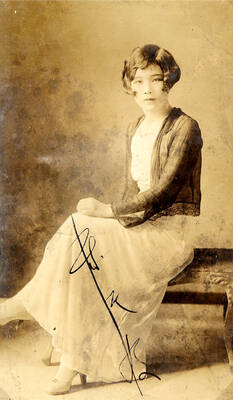On walls around Afghanistan’s scrappy capital, where million-US dollar mansions line rutted roads, anonymous graffiti artists are daubing their disapproving take on the devastating cost of war.
Styled after the anonymous British vandal-artist Banksy, Kabul’s streetwise stealth stencillers go by the moniker “Talibanksy,” a reference to the Islamist Taliban who have been waging war in Afghanistan for almost nine years.
The street art forms a commentary on the cost in blood and treasure of the war, which has brought 126,000 US and NATO troops to Afghanistan and kills about 2,000 Afghan civilians a year, according to the UN.
Black, spray-painted silhouettes of soldiers and dollar signs, poppies, helicopters and tanks, and children running hand-in-hand began appearing in downtown Kabul a few months ago.
Some silhouettes show the shadow of a helmeted soldier holding an assault rifle, inside a red circle with a line through it. Others have a silhouetted gun-toting trooper and a dollar sign joined by an equals symbol.
Or simply the words “cost of war.”
Financially the war is estimated to cost some US$100 million dollars a day, according to US media reports.
The human cost to foreign forces so far
this year is close to 170, according to the
icasualties.org Web site, which keeps tally and says that of the 1,737 who have died since the war began in 2001, 1,051 were American.
The people behind the anti-war graffiti call themselves Combat Communications, and claim to be “a small anonymous group of international artists founded last year with the sole aim of advocating/promoting free expression.”
According to a statement, they wish to remain anonymous and call their work “social and politically driven graphics.”
“This form of self-expression is open to anyone. The youth of Kabul have no real outlet for artistic expression,” it says, adding: “Do they want it?”
The Westerners behind Combat Communications declined interview requests, saying they wanted to keep a low profile while they developed their strategy.
Their graffiti appears across the central residential and commercial districts of Kabul, alongside spray-painted advertisements for translation services, real estate agents, plumbers, septic tank cleaners and roofers.
Since the fall of the Taliban, Afghanistan has begun moving towards democracy — with the second parliamentary election set for September — and freedom of expression is protected by the constitution.
Yet as the insurgency moves deep into its ninth year and the US-led counter-insurgency revs up with foreign troop numbers set to peak by August at 150,000, Kabul remains a city scarred by war and corruption.
Open drains run alongside the main roads, few side streets are paved, traffic control is derisory and public transport virtually non-existent.
Two-meter-high concrete blast walls surround most public buildings and embassies, and residential neighborhoods feature the “narco-tecture” of garishly-tiled, multi-story mansions, most believe are built with the proceeds of the US$3 billion-a-year illicit drugs trade.
A cloud of filth from diesel-powered vehicles sits atop a city surrounded on three sides by the peaks of the Hindu Kush mountains, and piles of garbage are picked over by beggars and animals alike.
Consumer price inflation is said to be around 20 percent, helicopter gunships provide an almost constant overhead clatter, and Afghans desperate to leave their country for a new life form long queues at visa offices.
Into this harsh landscape, the sudden appearance of modern street art has added a touch of color and controversy — and the blast walls provide the perfect canvas.
Talibanksy’s tags are not yet as ubiquitous as Banksy’s guerilla art became in London and other British cities over the past decade.
Nor is it as sophisticated, so far presenting little more than simple anti-war messages and slogans, in contrast to the infinitely more clever, caustic and creative Banksy murals.
And whereas Banksy branched out to the US, Australia and the Middle East, becoming an international phenomenon and wealthy in the process, Combat Communications appears to be starting out with more modest ambitions.
The statement contains an anti-capitalist message, hitting out at the massive billboards that dominate city intersections, advertising telecommunications firms or warning against involvement in the drugs trade.
“’Selling the peace’ AKA (also known as) winning the war, has also become a big industry. Propaganda is everywhere from counter-narcotic campaigns to counter-terrorism to army recruitment. You can’t move without some form of visual purposeful persuasion burning a hole in your soul,” it says.
“Social and politically driven graphics,
AKA street art, can evoke thought and stimulate discussion.
“Watch your public space,” the statement says.

In recent weeks the Trump Administration has been demanding that Taiwan transfer half of its chip manufacturing to the US. In an interview with NewsNation, US Secretary of Commerce Howard Lutnick said that the US would need 50 percent of domestic chip production to protect Taiwan. He stated, discussing Taiwan’s chip production: “My argument to them was, well, if you have 95 percent, how am I gonna get it to protect you? You’re going to put it on a plane? You’re going to put it on a boat?” The stench of the Trump Administration’s mafia-style notions of “protection” was strong

Every now and then, it’s nice to just point somewhere on a map and head out with no plan. In Taiwan, where convenience reigns, food options are plentiful and people are generally friendly and helpful, this type of trip is that much easier to pull off. One day last November, a spur-of-the-moment day hike in the hills of Chiayi County turned into a surprisingly memorable experience that impressed on me once again how fortunate we all are to call this island home. The scenery I walked through that day — a mix of forest and farms reaching up into the clouds

With one week left until election day, the drama is high in the race for the Chinese Nationalist Party (KMT) chair. The race is still potentially wide open between the three frontrunners. The most accurate poll is done by Apollo Survey & Research Co (艾普羅民調公司), which was conducted a week and a half ago with two-thirds of the respondents party members, who are the only ones eligible to vote. For details on the candidates, check the Oct. 4 edition of this column, “A look at the KMT chair candidates” on page 12. The popular frontrunner was 56-year-old Cheng Li-wun (鄭麗文)

Oct. 13 to Oct. 19 When ordered to resign from her teaching position in June 1928 due to her husband’s anti-colonial activities, Lin Shih-hao (林氏好) refused to back down. The next day, she still showed up at Tainan Second Preschool, where she was warned that she would be fired if she didn’t comply. Lin continued to ignore the orders and was eventually let go without severance — even losing her pay for that month. Rather than despairing, she found a non-government job and even joined her husband Lu Ping-ting’s (盧丙丁) non-violent resistance and labor rights movements. When the government’s 1931 crackdown